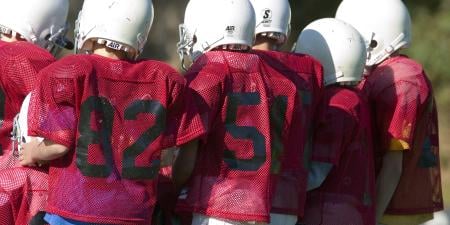“What I know most surely about morality and the duty of man,” Albert Camus declared, “I owe to sport” [1]. The throngs of coaches, trainers, parents, and spectators to American athletics might well cheer him on.
No other leisure activity in our culture can compete: we take sports and athletics to be not only panaceas for the body, but tutors for the soul. Most of us, implicitly or explicitly, believe that healthy participation in athletics enriches our sense of teamwork, self-discipline, and sportsmanship—that, deep down, athletic competition really is all for fun, and there is such a thing as going too far. The old bromide stands: it’s not about whether you win or lose; it’s about how you play the game.
But winning and losing can—and do—dominate our perception of athletic competition. Our success on the practice field could one day spell greater success in the arena. Teenaged quarterbacks fantasize about being drafted into the National Football League (NFL), while college-level gymnasts dream Olympian dreams. This is how mortals gain immortality, A.E. Housman reminds us in his poem, “To an Athlete Dying Young” [2]:
The time you won your town the race
We chaired you through the marketplace;
Man and boy stood cheering by,
And home we brought you shoulder-high.
And if we risk our lives to gain this privileged fame, what of it? In memorializing his athlete’s untimely demise, Housman declares,
Now you will not swell the rout
Of lads that wore their honor out,
Runners whom renown outran
And the name died before the man.
So do many young athletes believe: better to have won glory at the expense of longevity than to watch one’s former glory fade. Winning is everything.
The physician who serves any athlete confronts the fact that, simply put, this is the place where desire for winning performance may meet pathology. While any doctor would wish patients the best in their endeavors, he or she must also consider what constitutes a healthy endeavor. The tension between physical achievement and health lies at the heart of the physician-athlete relationship and frames the ethical dilemmas this issue of Virtual Mentor seeks to illustrate for practitioners.
One way in which athletes’ ambitions can create ethical dilemmas is by causing them to take inadvisable risks. Anthony Cortese dissects the culture of bodybuilding, particularly with regards to perceptions of health and beauty in American society.
In their case commentary, David Sohn and Robert Steiner consider a soccer player who asks her physician to clear her to play in a national championship—in spite of the fact that she has a torn anterior cruciate ligament (ACL). Bargaining for the physician’s cooperation, the soccer player states that she will assume liability for any complications that might arise. Drs. Sohn and Steiner lay out the ethical principles at stake in the situation: autonomy for the athlete who wishes to play at all costs and the physician’s obligation to do no harm.
In their case commentary, Christopher Madden, Aaron Campbell, and Jessica Pierce discuss a situation in which a patient receiving a pre-travel evaluation from a high-end concierge physician requests corticosteroids to improve his acclimatization and, he believes, enhance his performance on a high-altitude climbing adventure. Drs. Madden, Campbell, and Pierce explain the dynamics of patient-physician relationships in concierge medicine and the need for physicians experienced in pre-participation evaluations. Prescribing a substantial “dose of reality,” they underline the need for physicians to be forthright in their recommendations to patients who are intending to sacrifice well-being for the sake of unrealistic goals—which may also endanger the health of others on that athlete’s team.
When it comes to contact sports like American football, the playing field has grown very complex indeed. Richard Weinmeyer discusses the litigation concerning concussions in the NFL. Many states have passed laws to protect athletes from the adverse effects of multiple concussions, thus complicating the clinician’s obligations to young patients. Kevin D. Walter discusses further prevention strategies for concussions among young athletes. In their case commentary, Michael O’Brien and William Meehan share their insight on the dilemma of a doctor whose teenage patient wants to play high school football. His parents have conflicting views on the subject: one believes that sports like football present unacceptable risks to young athletes and one considers that the desirable benefits of sports outweigh those risks. In elucidating the ethical concerns underlying this case, O’Brien and Meehan tease out the challenges the situation entails: should young athletes be allowed to participate in any sport they choose, or should physicians recognize and advise limits based on the youths’ histories and how injury-prone they are?
Another arena in which athletes’ ambition can lead to ethical questions is that of doping. Gary A. Green explains the use of human growth hormone for performance enhancement and evolving tests for detecting it. John Hoberman considers physician complicity in performance-enhancing drug use in both professional athletics and “rejuvenation” clinics. Ed Laskowski draws on his experiences as a US Olympic team physician in a podcast interview on the physician-athlete relationship.
Lastly, Andrew Courtwright takes up the meta-issue of how we talk about performance enhancement in his review of Simon M. Outram’s article “Discourses of Performance Enhancement: Can We Separate Performance Enhancement from Performance Enhancing Drug Use?”
We hope the reader finds reading this issue as thought-provoking, stimulating, and entertaining as we found preparing it to be. These topics constitute a major area of concern for many clinicians, both in sports medicine specialties and primary care practice. Performance-enhancing drugs, brutal fitness regimens, and unrealistic expectations of athletic success have become endemic in many parts of America, but these stark realities need not define sport. With the right medical guidance, expertise, and compassion, sports and fitness can remain central to many athletes’ knowledge of “morality and the duty of man.”
References
-
Lottman HR. Albert Camus: A Biography. Garden City, NY: Doubleday; 1979.
-
Housman AE. To an athlete dying young. A Shropshire Lad. New York: Dodd, Mead; 1922.



